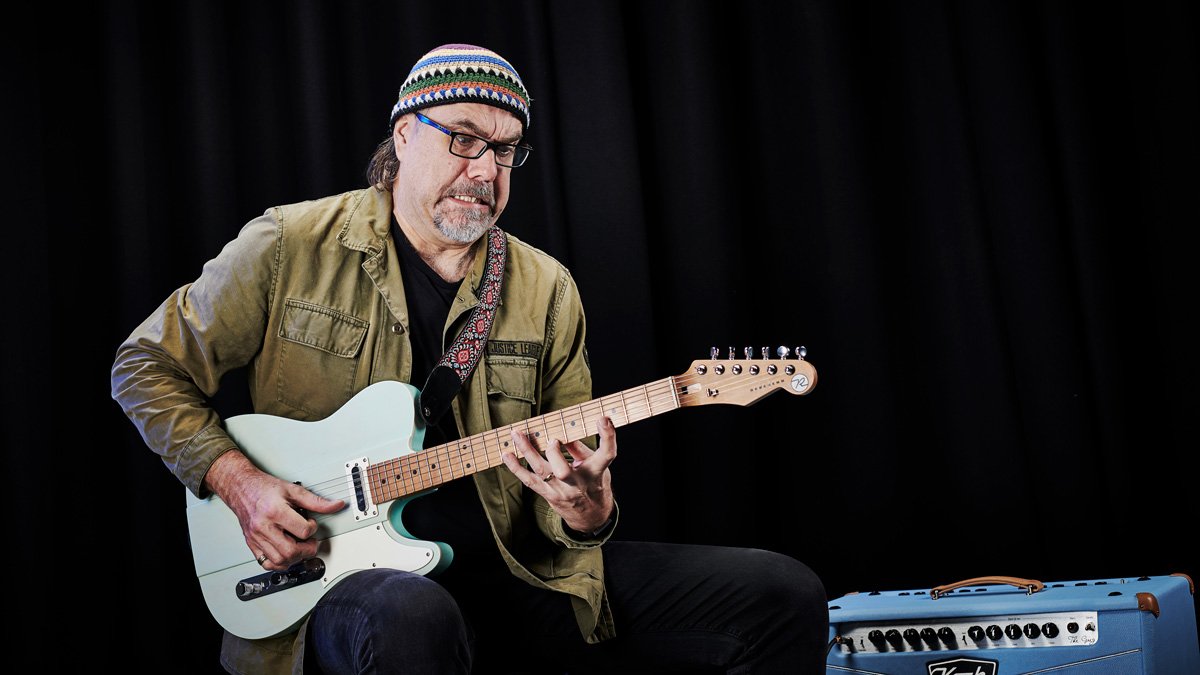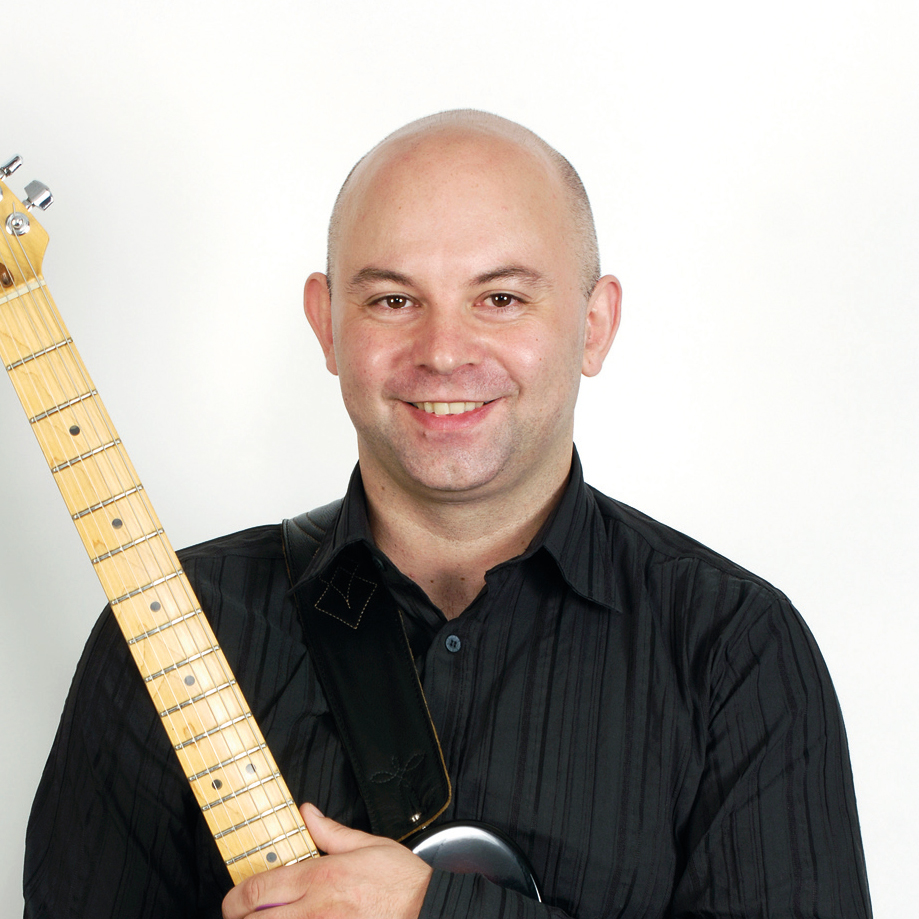“I’m basically a blues-rock guitar player that got wise to some other stuff”: Greg Koch is one of guitar's great showmen – and his licks are phenomenal
Strap yourself in, it's time for our lesson in the art of Greg Koch – the funny guy with a staggering command of a huge range of styles

Greg Koch is an amazing guitar player, plus he’s also a wonderful showman and an extremely funny guy with an obvious love and infectious enthusiasm for music and all things guitar.
If you’ve not heard him play, then the easiest way to get us in the right place would be to look at his influences – as he himself says, “I’m basically a blues-rock guitar player that got wise to some other stuff, out of both necessity and to keep myself interested”.
Koch started playing at the age of 12, inspired by his elder brother’s vinyl collection, and in particular records by The Jimi Hendrix Experience and Cream.
From here, he progressed onto Jimmy Page and Jeff Beck before tracing all these players’ roots backwards via B.B. and Albert King. Discovering Albert Lee on an old Eric Clapton album prompted an exploratory excursion into county territory via Ray Flacke and Ricky Skaggs, and let’s not forget his exposure to jazz that occurred primarily while at music college, inspiring a love of all things Charlie Christian and George Benson.
While in his mid-20s, Koch was working in a music shop in his native Milwaukee during the day and playing bar gigs by night. He caught the ear of a travelling Fender rep that was visiting the store and staying in the area that night. So impressed by Greg’s playing was he, that our guy from Fender dropped by to catch his live set later that evening. Now this really knocked him out, so much so that he offered him a Fender endorsement.
A series of clinics followed, and Koch was ultimately spotted while performing on the Fender stand at the NAMM show in Anaheim by a representative of Steve Vai’s Favored Nations label. Within months, Greg had secured a deal with Vai and a book and DVD deal with the mighty Hal Leonard publishing company.
Koch’s career has since gone from strength to strength, with an impressive catalogue of album releases, a massive portfolio of tuitional material, along with a range of signature equipment and a healthy online presence. He currently performs in the mostly instrumental Koch Marshall Trio, alongside Hammond B3 player Toby Lee Marshall, and with Greg’s son, Dylan, playing drums.
Arguably the most impressive aspect of Greg’s playing is his remarkable stylistic range. You’ll hear ideas ranging from classic blues and rock phrasing, terrifying chicken picking and harmonically sophisticated jazzy lines negotiating the changes, and all of this delivered with wonderful tone, time and extraordinary musical taste.
The musical examples that follow are designed to capture and illustrate some of this stylistic range by juxtaposing a variety of idiomatic approaches against a set of non-diatonic shifting chords, moving through Am7, Cm7 and Bb7 tonalities. We begin with a pair of contrasting phrases showcasing Greg’s classic rock and jazz influences before moving on to establish some effective soloing tools and devices.
We end with a cohesive solo that moves through classic rock and roll moves, country and jazz inspired ideas in just 12 small but perfectly formed bars. There’s tons to get to grips with so let’s get going. And, as always, enjoy!
Get the tone
Amp Settings: Gain 7, Bass 4, Middle 5, Treble
Greg has a range of signature gear, starting with his T-style Reverend guitar loaded with Fishman Fluence pickups and Koch (no relation) guitar amp with classic stompboxes.
We’re after a fairly driven tone, controlling the gain with the guitar’s volume control and your picking attack. Explore pickup options and experiment with picking position and dynamic variations.
Example 1. Greg’s melting pot of styles
We begin by looking at a pair of contrasting licks inspired by Greg’s extraordinarily vast lick bag, starting with a pentatonic blues-rock idea against a modal chord sequence shifting between Am7, Cm7, returning to Am7 and finally resting on Bb7.
The scales of choice are A minor pentatonic (A-C-D-E-G), C minor pentatonic (C-Eb-F-G-Bb) and Bb major pentatonic (Bb-C-D-F-G). The second line is more of a jazzy fusion-like affair; we’re still thinking A minor pentatonic, although we’re adding the 2nd (B) and b5 (Eb).
Against C minor we’re using C Dorian (C-D-Eb-F-G-A-Bb), while for Bb7 our scale of choice is Bb Lydian dominant (Bb-C-D-E-F-G-Ab), the fourth mode of F melodic minor scale. This example is packed with musical information, so tackle it slowly at first.
Example 2. Scales and melodic tools
Let’s now explore a variety of options against the same harmonic events, Am7, Cm7 and Bb7. The trick here is to both visualise and execute these Pentatonic, diatonic and arpeggio based ideas in the same fretboard location.
We begin with a different pentatonic option for each; for the minor chords we’re selecting the same choices as Ex1, while for Bb7, here we’ve selected Bb dominant pentatonic (Bb-C-D-F-Ab).
Next up we define a seven-note modal option for each chord, Dorian for both Am7 and Cm7 and Lydian dominant again for Bb7. We end this study by playing these same scale ideas although in arpeggio form, essentially playing every other note (R-3-5-7-9-11-13), giving us all seven available tones but taking two octaves to complete the sequence.
Example 3. Complete solo
We round up this look at Greg’s style with a soloing study against the same shifting modal sequence as before, although looped three times, giving us 12 bars in total. While this works as a cohesive piece, you could also consider this to be a collection of six contrasting two-bar ideas, each showcasing a different facet of Koch’s stylistically diverse style.
First up we see some rock and roll double-stops, followed by a more country-like idea sliding into both A minor pentatonic and Bb9th arpeggios (Bb-D-F-Ab-C). In bars 5 and 6 we are in classic blues-rock territory, before morphing into some country open-string action.
The final pair of phrases is more jazz-inspired, with chromatically decorated arpeggios in bars 9 and 10, ending with a bebop Dorian/melodic minor line to end. As always, use these lines as the start of your journey, aiming to create as many variations as you can and personalise these ideas any way you see fit.
Get The Pick Newsletter
All the latest guitar news, interviews, lessons, reviews, deals and more, direct to your inbox!
John is Head of Guitar at BIMM London and a visiting lecturer for the University of West London (London College of Music) and Chester University. He's performed with artists including Billy Cobham (Miles Davis), John Williams, Frank Gambale (Chick Corea) and Carl Verheyen (Supertramp), and toured the world with John Jorgenson and Carl Palmer.
“There are so many sounds to be discovered when you get away from using a pick”: Jared James Nichols shows you how to add “snap, crackle and pop” to your playing with banjo rolls and string snaps
Don't let chord inversions bamboozle you. It's simply the case of shuffling the notes around










![Joe Bonamassa [left] wears a deep blue suit and polka-dotted shirt and plays his green refin Strat; the late Irish blues legend Rory Gallagher [right] screams and inflicts some punishment on his heavily worn number one Stratocaster.](https://cdn.mos.cms.futurecdn.net/cw28h7UBcTVfTLs7p7eiLe.jpg)


